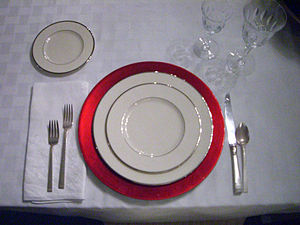AY Honors/Community Improvement/Requirements
From Pathfinder Wiki
< AY Honors | Community ImprovementAY Honors/Community Improvement/Requirements /
14. Know the rules of table etiquette which make it easier for you and those around you, such as what to do with your knife and fork after using them. Know how to be a welcome dinner guest and a joy to your hosts.
Table manners are the etiquette used when eating. This includes the appropriate use of utensils. Different cultures have different standards for table manners. Many table manners developed out of practicality. For example, it is generally impolite to put elbows on tables since doing so creates a risk of tipping over bowls and cups. Within different families or groups, there may be less rigorous enforcement of some traditional table manners of their culture while still maintaining others. For example, some families ignore elbows on the table or mixing of foods.
Table Layout
- Bread plates are to the left of the main plate, beverage glasses are to the right.
- Salad fork, knife and soup spoon are further from the main plate than the main course knife, fork and spoon. Dessert utensils are either placed above the main plate or served with dessert.
- The sharp edge of the knife blade faces the plate.
General Behavior
- Chew with your mouth closed.
- Do not talk at an excessively loud volume.
- Refrain from coughing, sneezing or blowing nose at the table.
- Never tilt back your chair while at the table, or at any other time.
- Do not make unbecoming noises while eating.
- Do not play with food or table utensils.
- Do not single out or chastise someone who has shown poor table manners.
- Do not put your elbows on the table or slouch. It is acceptable, however, to rest forearms, up to the elbow, on the table.
- Always ask the host or hostess to be excused before leaving the table.
- Do not stare at anyone while he or she is eating.
- Never talk on your phone at the table. If urgent, ask host or hostess to be excused, and go outside. Apologize after returning.
Utensils
- Do not eat food with your fingers unless you are eating foods customarily eaten with fingers, such as bread, French fries, chicken wings, pizza, etc. At more formal occasions, it is acceptable to eat asparagus or some romaine lettuce dishes with ones hands. However, as this is an obscure etiquette rule, in more casual settings, it is customary to use utensils.
- The fork may be used either in the American (use the fork in your left hand while cutting; switch to right hand to pick up and eat a piece) or the Continental (fork remains in the left hand) fashion -- either is now acceptable.
- The fork is used to convey any solid food to the mouth.
- The knife blade should be placed on the edge of your plate when not in use. The blade should always face inward.
- When you have finished eating soup, the spoon should be placed to the side of the saucer, not left in the bowl.
- Keep your napkin on your lap. At more formal occasions all diners will wait to place their napkins on their laps until the host or hostess places his or her napkin on his or her lap.
- When eating barbecue or some other messy foods, a 'bib' napkin may be provided for and used by adults. Usually these foods are also eaten by hand, and wet wipes or paper napkins should be used to clean the hands.
- When using paper napkins, never ball them up or allow stains to show.
- Use your silverware from the outside moving inward toward the main plate. (Salad fork, knife and soup spoon are further from the main plate than the main course knife, fork and spoon. Dessert utensils are either placed above the main plate or served with dessert.)
Dining
- A prayer or 'blessing' may be customary in some families, and the guests should join in even if they are not religious or do not follow the same religion. Most prayers are made by the host before the meal is eaten. Instead or in addition, a 'toast' may be offered.
- Do not start eating until (a) every person is served or (b) those who have not been served request that you begin without waiting. At more formal occasions all diners will wait to begin until the hostess or host lifts a fork or spoon.
- When a dish is presented 'family style', the food is served to one's plate and then passed on to the next person. Put the food on your left, take some and pass to the person next to you.
- When serving, serve from the left and pick up the dish from the right. Beverages are both served and removed from the right.
- Eat soup noiselessly and with the side of the spoon.
- Hot drinks should never be poured into the saucer to cool but should be sipped from the cup. Alternatively, ice may be used to cool them.
- Seasoning one's meal prior to tasting can be considered rude and may insult the chef.
At the end of the meal
- It is acceptable in most places to not finish all of the food on your plate.
- When finished with your meal, place your knife and fork with handles at the 4 o'clock position and the tines of the fork down to signal to the server you are done.
- Except in a public restaurant, do not ask to take some of your uneaten food away from the meal after it ends, and never when attending a formal dinner.

